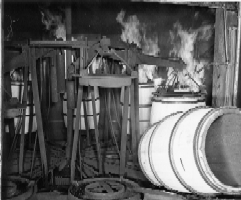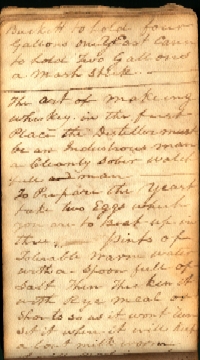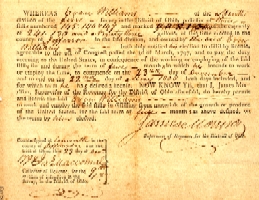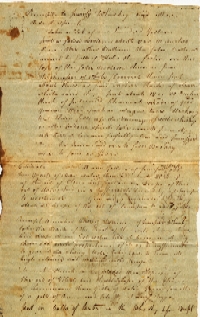Early Distilling Papers at The Filson
By Michael R. Veach
Special Collections Assistant
About |
 The Filson Historical Society has a growing collection of papers and printed material dealing with Kentucky’s
distilling past. This industry has always played an important role in the history of the Ohio Valley
region, but its earliest records are hard to find. The Filson has a significant portion of these early papers
in its manuscript collection.
The Filson Historical Society has a growing collection of papers and printed material dealing with Kentucky’s
distilling past. This industry has always played an important role in the history of the Ohio Valley
region, but its earliest records are hard to find. The Filson has a significant portion of these early papers
in its manuscript collection.
America’s first excise tax was on whiskey in 1791. This tax would lead to America’s first tax rebellion in 1794
known as the “Whiskey Rebellion.” The tax was later repealed in 1802 during the Jefferson Administration. There was a brief
period of taxation between 1812 and 1817 to pay the debts of the War of 1812, but taxation was not again a factor in the
industry until 1861. The official records of these taxes were stored in the Federal Building in Louisville and were lost during the flood of 1937, making
official accounts of early distilleries hard to find. The distillers were issued a license for their stills and there are
samples of these licenses for Evan Williams (Misc. Papers, Evan Williams and Fenley-Williams Family Papers, 1756-1951), Isaac Fenley (Fenley-
Williams Family Papers, 1756-1951), John Stone (Eli H. Brown Papers), and Daniel Weller (Weller Family Papers). Examples of the licenses from the
second period of  taxation can be found in the Eli Huston Brown III papers for Milly Stone and Eli H. Stone. These
licenses show the number of stills, the still capacity and the county in which they were located and are often the
only record remaining for the distillery.
taxation can be found in the Eli Huston Brown III papers for Milly Stone and Eli H. Stone. These
licenses show the number of stills, the still capacity and the county in which they were located and are often the
only record remaining for the distillery.
These early distillers were farmer distillers who made whiskey from their surplus grain. There are some records of this distilling activity in the form of recipes for making their distiller’s beer and recipes for making other products from new whiskey. Distiller’s beer is the fermented grain mash from which whiskey is made. In the Brown collection there is a recipe from John Stone for making whiskey using the “Pennington Method” that is a basic bourbon recipe with corn, rye, and malted barley. This is an undated document but probably dates to the first decade of the 19th century. There is also a recipe for growing yeast and making the distiller’s beer in the Jonathan Taylor diary that dates to about the same period as the Stone recipe.
 These early distilled spirits were not
an aged product and the farmers often
had their own recipes for making the
whiskey more palatable. The Corlis-Respess family papers have many recipes for making products such as
gin and blackberry cordial out of this
un-aged spirit. These recipes called for
the botanicals or fruits to be steeped in
the whiskey for a period of time, giving
the product the desired flavor. The
Beall-Booth family papers also include
recipes for making cordial, cherry
bounce, and punch from the same era,
but this undated document goes one
step further. It calls for purifying the
whiskey before use and describes this
purification process. It calls for a
100 gallon tub with a “false bottom”
filled with holes. On top of this false
bottom place three or four layers of
white flannel and then about three
inches of clean white sand. On top
of the sand place about
18 inches of pulverized
charcoal from a sugar
tree or hickory. Pour the
new whiskey on
top of this and let it
drain out the bottom.
This is a smaller version
of the “Lincoln County
Process” used to make
Tennessee whiskey.
The document even
has a small drawing
illustrating how the vat
should look.
These early distilled spirits were not
an aged product and the farmers often
had their own recipes for making the
whiskey more palatable. The Corlis-Respess family papers have many recipes for making products such as
gin and blackberry cordial out of this
un-aged spirit. These recipes called for
the botanicals or fruits to be steeped in
the whiskey for a period of time, giving
the product the desired flavor. The
Beall-Booth family papers also include
recipes for making cordial, cherry
bounce, and punch from the same era,
but this undated document goes one
step further. It calls for purifying the
whiskey before use and describes this
purification process. It calls for a
100 gallon tub with a “false bottom”
filled with holes. On top of this false
bottom place three or four layers of
white flannel and then about three
inches of clean white sand. On top
of the sand place about
18 inches of pulverized
charcoal from a sugar
tree or hickory. Pour the
new whiskey on
top of this and let it
drain out the bottom.
This is a smaller version
of the “Lincoln County
Process” used to make
Tennessee whiskey.
The document even
has a small drawing
illustrating how the vat
should look.
Aged whiskey did
not become common
in Kentucky until the
mid 1820s. The Filson
Historical Society
has the earliest known reference to
charring barrels for the purpose of
aging whiskey (in the Corlis-Respess
Family papers). John Corlis moved to
Bourbon County in the late 1810s and
bought a farm and a distillery. In a letter
dated 15 February 1826, J. M. Pike
of Lexington, discusses purchasing 100
barrels of Corlis’ whiskey. He is very
pleased with the product and has no
doubts about selling all 100 barrels,
but states “it is suggested to me, that if
our barrels should be burnt upon the
inside,  say only the 16th of an inch,
that it will much improve it, of this
however I presume you are the best
judge”. This is a Lexington businessman
telling a Bourbon County distiller
how to make Bourbon Whiskey.
say only the 16th of an inch,
that it will much improve it, of this
however I presume you are the best
judge”. This is a Lexington businessman
telling a Bourbon County distiller
how to make Bourbon Whiskey.
The library at The Filson Historical Society also has resources for those wishing to research the early Kentucky distillers. The best source for such information is the book Kentucky Bourbon: The Early Years of Whiskeymaking by Henry G. Crowgey (University Press of Kentucky, 1971). This book is based upon his dissertation from the University of Kentucky and is a very good source for early Kentucky distillers and distilleries. He also discusses the origin of bourbon and the “first Kentucky distiller” question. His research is very thorough and well documented.
 The library also has a very interesting
item in its pamphlet collection.
This is a section from the Congressional
Record for 27 July 1888 that
discusses increasing the Bonding
Period for whiskey from four to eight
years. It gives the testimony of several
Kentucky distillers, including John
Atherton, who describes the process
for making bourbon in some detail.
Atherton also states that when anyone
in the business discusses Kentucky
whiskey, it has long been understood
that the whiskey is made for the
purpose of aging. Whiskey from other
states is often sold new, but Kentucky
whiskey is an aged product.
The library also has a very interesting
item in its pamphlet collection.
This is a section from the Congressional
Record for 27 July 1888 that
discusses increasing the Bonding
Period for whiskey from four to eight
years. It gives the testimony of several
Kentucky distillers, including John
Atherton, who describes the process
for making bourbon in some detail.
Atherton also states that when anyone
in the business discusses Kentucky
whiskey, it has long been understood
that the whiskey is made for the
purpose of aging. Whiskey from other
states is often sold new, but Kentucky
whiskey is an aged product.
The researcher looking into the early years of Kentucky distilling will find many resources at The Filson Historical Society. These resources in Special Collections and the Library offer a rare glimpse into the history of this important Kentucky industry.
The Filson Historical Society
1310 South Third Street - Louisville, KY 40208
Phone: (502) 635-5083 Fax: (502) 635-5086
Hours
The Ferguson Mansion and Office
Monday - Friday: 9 am. - 5 pm.
Saturday and Sunday closed
Library
Monday - Friday: 9 am. - 5 pm.
Saturday: 9 am. - 12 noon
